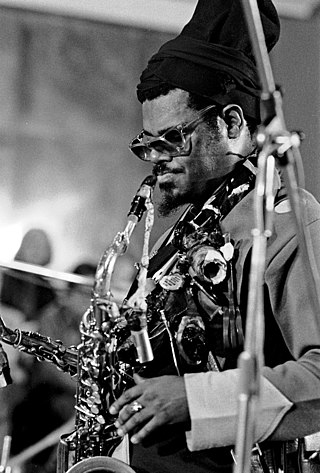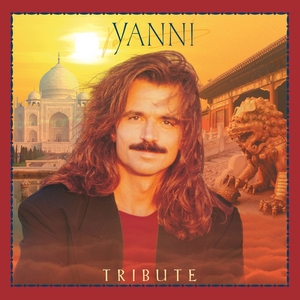
Rahsaan Roland Kirk, known earlier in his career simply as Roland Kirk, was an American jazz multi-instrumentalist who played tenor saxophone, flute, and many other instruments. He was renowned for his onstage vitality, during which virtuoso improvisation was accompanied by comic banter, political ranting, and the ability to play several instruments simultaneously.

The Taj Mahal is an ivory-white marble mausoleum on the right bank of the river Yamuna in Agra, Uttar Pradesh, India. It was commissioned in 1631 by the fifth Mughal emperor, Shah Jahan to house the tomb of his beloved wife, Mumtaz Mahal; it also houses the tomb of Shah Jahan himself. The tomb is the centrepiece of a 17-hectare (42-acre) complex, which includes a mosque and a guest house, and is set in formal gardens bounded on three sides by a crenellated wall.

Henry St. Claire Fredericks Jr., better known by his stage name Taj Mahal, is an American blues musician. He plays the guitar, piano, banjo, harmonica, and many other instruments, often incorporating elements of world music into his work. Mahal has done much to reshape the definition and scope of blues music over the course of his more than 50-year career by fusing it with nontraditional forms, including sounds from the Caribbean, Africa, India, Hawaii, and the South Pacific.

Agra is a city on the banks of the Yamuna river in the Indian state of Uttar Pradesh, about 230 kilometres (140 mi) south-east of the national capital Delhi and 330 km west of the state capital Lucknow. With a population of roughly 1.6 million, Agra is the fourth-most populous city in Uttar Pradesh and twenty-third most populous city in India.

Mumtaz Mahal was the empress consort of Mughal Empire from 1628 to 1631 as the chief consort of the fifth Mughal emperor, Shah Jahan. The Taj Mahal in Agra, often cited as one of the Wonders of the World, was commissioned by her husband to act as her tomb.

Howard Lewis Johnson was an American jazz musician, known mainly for his work on tuba and baritone saxophone, although he also played the bass clarinet, trumpet, and other reed instruments. He is known to have expanded the tuba’s known capacities in jazz.

Hot Rats is the second solo album by Frank Zappa, released in October 1969. It was Zappa's first recording project after the dissolution of the original version of the Mothers of Invention. Five of the six songs are instrumental; while "Willie the Pimp", features vocals by Captain Beefheart. In his original sleeve notes, Zappa described the album as "a movie for your ears".

The Agra Fort is a historical fort in the city of Agra, and also known as Agra's Red Fort. Mughal emperor Humayun was crowned at this fort. It was later renovated by the Mughal emperor Akbar from 1565 and the present-day structure was completed in 1573. It served as the main residence of the rulers of the Mughal dynasty until 1638, when the capital was shifted from Agra to Delhi. It was also known as the "Lal-Qila" or "Qila-i-Akbari". Before being captured by the British, the last Indian rulers to have occupied it were the Marathas. In 1983, the Agra fort was inscribed as a UNESCO World Heritage Site because of its importance during the Mughal Dynasty. It is about 2.5 kilometers (1.6 mi) northwest of its more famous sister monument, the Taj Mahal. The fort can be more accurately described as a walled city. It was later renovated by Shah Jahan.
Joseph Spence was a Bahamian guitarist and singer. He is well known for his vocalizations and humming while playing the guitar. Several American musicians, including Taj Mahal, the Grateful Dead, Ry Cooder, Catfish Keith, Woody Mann, and Olu Dara, as well as the British guitarist John Renbourn, were influenced by and have recorded variations of his arrangements of gospel and Bahamian songs.

Curtis DuBois Fuller was an American jazz trombonist. He was a member of Art Blakey's Jazz Messengers and contributed to many classic jazz recordings.

Henry Thomas was an American country blues singer, songster and musician. Although his recording career, in the late 1920s, was brief, Thomas influenced performers including Bob Dylan, Taj Mahal, the Lovin' Spoonful, the Grateful Dead, and Canned Heat. Often billed as "Ragtime Texas", Thomas's style is an early example of what later became known as Texas blues guitar.

Jesse Edwin Davis III was an American guitarist. He was well regarded as a session artist and solo performer, was a member of Taj Mahal's backing band and played with musicians such as Eric Clapton, John Lennon, and George Harrison. In 2018, he was posthumously inducted into the Native American Music Hall of Fame at the 18th Annual Native American Music Awards. Davis was an enrolled citizen of the Kiowa Indian Tribe of Oklahoma with Comanche, Muscogee, and Seminole ancestry.
Paul Horn was an American flautist, saxophonist, composer and producer. He became a pioneer of world and new age music with his 1969 album Inside. He received five Grammy nominations between 1965 and 1999, including three nominations in 1965.

Tribute is the second live album and third concert film by Greek keyboardist and songwriter Yanni, released in November 1997 on Virgin Records. It was recorded at the Taj Mahal, India in March 1997 and the Forbidden City, China, in May 1997, both featuring Yanni performing with a seven-piece band, choir, and 27-piece orchestra.

Ronald Edward Cuber was an American jazz saxophonist. He also played in Latin, pop, rock, and blues sessions. In addition to his primary instrument, baritone sax, he played tenor sax, soprano sax, clarinet, and flute, the latter on an album by Eddie Palmieri as well as on his own recordings. As a leader, Cuber was known for hard bop and Latin jazz. As a side man, he had played with B. B. King, Paul Simon, and Eric Clapton. Cuber can be heard on Freeze Frame by the J. Geils Band, and one of his most spirited performances is on Dr. Lonnie Smith's 1970 Blue Note album Drives. He was also a member of the Saturday Night Live Band.

The Culture of Uttar Pradesh is an Indian culture which has its roots in Hindi, Bhojpuri and Urdu literature, music, fine arts, drama and cinema. Lucknow, the capital of Uttar Pradesh, has historical monuments including Bara Imambara and Chhota Imambara, and has preserved the damaged complex of the Oudh-period British Resident's quarters, which are being restored.
Lee Underwood is an American musician and journalist who played lead guitar with Tim Buckley for most of Buckley's career.
Jules Timothy Weisberg is an American flutist, vocalist, and record producer.

Sunflower is an album by vibraphonist Milt Jackson recorded in 1972 and released on the CTI label. Assisting Jackson are trumpeter Freddie Hubbard, a star-studded rhythm section composed chiefly of Miles Davis alumni, and, on the first track, string and woodwind accompaniment, courtesy of Don Sebesky.
Tony Braunagel is an American drummer, producer, and songwriter from Houston, Texas, United States, who is based in Los Angeles, California. Braunagel has played on many film scores and television shows as well as numerous albums as a musician, composer and producer. He is best known as a session drummer and/or percussionist of over 200 albums including those of Otis Rush, Eric Burdon, Johnny Nash, Coco Montoya, Lucky Peterson, as well as Grammy winning albums of Bonnie Raitt, Taj Mahal, Buddy Guy (percussion) and for performing live with dozens of music icons including Bonnie Raitt, Rickie Lee Jones, BB King, Lightnin’ Hopkins, John Lee Hooker, Robert Cray, Bette Midler, Lyle Lovett, and Taj Mahal to name just a few.
















